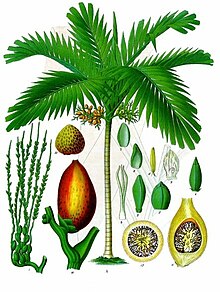Areca is a genus of 51 species of palms in the family Arecaceae, found in humid tropical forests from the islands of the Philippines, Malaysia and India, across Southeast Asia to Melanesia.[1][3] The generic name Areca is derived from a name used locally on the Malabar Coast of India.
| Areca | |
|---|---|

| |
| Areca catechu – 1897 illustration[2] | |
| Scientific classification | |
| Kingdom: | Plantae |
| Clade: | Tracheophytes |
| Clade: | Angiosperms |
| Clade: | Monocots |
| Clade: | Commelinids |
| Order: | Arecales |
| Family: | Arecaceae |
| Subfamily: | Arecoideae |
| Tribe: | Areceae |
| Subtribe: | Arecinae |
| Genus: | Areca L. |
| Type species | |
| Areca catechu [1] | |
| Synonyms[3] | |
| |
Usage
editThe best-known member of the genus is A. catechu, the areca nut palm.[1][4] Several species of areca nuts, known for their bitter and tangy taste, raw or dried, are routinely used for chewing, especially in combination with the leaves of betel and dried leaves of tobacco. Areca nut is also popularly referred to as betel nut because of its usage for chewing with betel leaves. In Assam, areca nut is also known as tamul in the local dialect.
Cultural significance
editThe Areca palm, mainly known for its Areca nuts, holds profound cultural and historical significance in Southeast Asia and the Indian subcontinent. These regions, steeped in rich traditions, have integrated Areca into various aspects of life.
- Religious and Social Rituals: Areca nuts are traditionally used in religious rituals and social ceremonies. Hindu weddings, for instance, symbolize long-lasting marriage and are often exchanged during the practices. Similarly, in many Asian cultures, offering Areca nuts to guests is a sign of respect and hospitality.
- Symbolism: The Areca nut, often paired with betel leaves, symbolizes various cultural aspects. For example, in some parts of India, this combination represents love and is used in love potions.
- Art and Literature: Areca has been depicted in various forms of art and literature, symbolizing different themes ranging from fertility to prosperity.
- Traditional Medicine: In the Indian subcontinent, Areca nuts have been used in traditional medicine for their supposed health benefits, though modern research has raised concerns about their health impacts.
- Economic Aspect: Beyond its cultural relevance, Areca cultivation is essential to the rural economy in many parts of Southeast Asia and the Indian subcontinent, providing livelihoods to millions of farmers.
- Festivals and Celebrations: Certain festivals, especially in India and Southeast Asia, involve using Areca nuts. They are considered auspicious and are used in various traditional dishes and offerings.
Species
edit(51 species)
- Areca abdulrahmanii J.Dransf.
- Areca ahmadii J.Dransf.
- Areca andersonii J.Dransf.
- Areca gandamatu Sultan Mardan Plantation
- Areca arundinacea Becc.
- Areca brachypoda J.Dransf.
- Areca caliso Becc.
- Areca camarinensis Becc.
- Areca catechu L.
- Areca celebica Burret
- Areca chaiana J.Dransf.
- Areca concinna Thwaites
- Areca congesta Becc.
- Areca costulata Becc.
- Areca dayung J.Dransf.
- Areca furcata Becc.
- Areca glandiformis Lam.
- Areca guppyana Becc.
- Areca gurita Heatubun
- Areca hutchinsoniana Becc.
- Areca insignis (Becc.) J.Dransf.
- Areca ipot Becc.
- Areca jobiensis Becc.
- Areca jugahpunya J.Dransf.
- Areca kinabaluensis Furtado
- Areca klingkangensis J.Dransf.
- Areca laosensis Becc.
- Areca ledermanniana Becc.
- Areca macrocalyx Zipp. ex Blume
- Areca macrocarpa Becc.
- Areca minuta Scheff.
- Areca montana Ridl.
- Areca multifida Burret
- Areca nannospadix Burret
- Areca nigasolu Becc.
- Areca novohibernica (Lauterb.) Becc.
- Areca oxycarpa Miq.
- Areca parens Becc.
- Areca rechingeriana Becc.
- Areca rheophytica J.Dransf.
- Areca ridleyana Becc. ex Furtado
- Areca rostrata Burret
- Areca salomonensis Burret
- Areca subacaulis (Becc.) J.Dransf.
- Areca torulo Becc.
- Areca triandra Roxb. ex Buch.-Ham.
- Areca tunku J.Dransf. & C.K.Lim
- Areca vestiaria Giseke
- Areca vidaliana Becc.
- Areca warburgiana Becc.
- Areca whitfordii Becc.
See also
edit- Dypsis lutescens, a plant also sometimes referred to as "Areca palm"
References
edit- ^ a b c Charlie D. Heatubun; John Dransfield; Thomas Flynn; Sri S. Tjitrosoedirjo; Johanis P. Mogea; William J. Baker (2012). "A monograph of the betel nut palms (Areca: Arecaceae) of East Malesia". Botanical Journal of the Linnean Society. 168 (2): 147–173. doi:10.1111/j.1095-8339.2011.01199.x.
- ^ Areca catechu – the Areca palm. In botanical drawing from Köhler's Medizinal-Pflanzen – by Franz Eugen Köhler, in 1897.
- ^ a b Kew World Checklist of Selected Plant Families
- ^ Zumbroich, Thomas J. (2008). "The origin and diffusion of betel chewing: A synthesis of evidence from South Asia, Southeast Asia and beyond". e-Journal of Indian Medicine. 1 (3): 87–140.